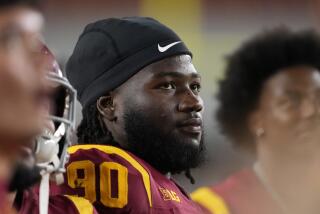New Buccaneer Comes Way Back : Tampa Bay: After 20 months off, running back Gary Anderson proves he’s none the worse for lack of wear.
Even the most casual NFL observer has figured it out by now. No matter how many coaches stress the importance of attending training camp--you know, timing, rhythm, conditioning, practice makes perfect and all that--it simply isn’t necessary.
Just ask the Philadelphia Eagles. Holdout Lawrence Taylor returns to the New York Giants’ practice field for a couple of days and then wreaks havoc in the Eagle backfield.
The list of the training camp myth-busters grows each year. More and more big-name holdouts return to action apparently none the worse for the lack of wear.
If this trend has your favorite NFL coach grumbling about the deterioration of discipline in this grand old game, don’t tell him about Gary Anderson. The Tampa Bay running back is proof that while 40 days off probably won’t hurt a guy, 20 months away can be downright rejuvenating.
Anderson, who sat out the entire 1989 season because of a contract dispute with the San Diego Chargers, arrived in Tampa Bay via a trade this spring. And, last Sunday, he arrived in the Detroit Lion secondary with alarming frequency during his first game in almost two years.
He carried 21 times for 74 yards and caught six passes for 79 yards and the go-ahead touchdown in the Buccaneers’ 38-21 victory. On nine of the 15 times Tampa Bay faced a third down, Anderson got the call. Six times, he picked up the first down.
“I really felt pretty good,” Anderson said.
So how’d he do it? Did he hire some out-of-work linemen to come over to his back yard so he could practice reading blocks? Did he employ the services of a personal trainer and a nutritionist to stay in shape?
“I’d get up and work out between 5 and 6 in the morning, then I’d get home in time to take my kids to school,” he said.
OK, so he ran and lifted weights, but this was hardly a Rocky training regimen. These days, many people push themselves through a similar routine a couple of times a week.
Gary Anderson’s smashing re-entry into the NFL’s Sunday night highlight show circuit had little to do with morning jogs and weight rooms. He returned with the same explosive speed, instinct and exceptional pass-catching ability that helped him become a constant threat to break a big play with the Chargers.
Anderson averaged five yards per carry and gained 1,119 yards with San Diego in 1988.
Anderson’s success, according to Ram defensive coordinator Fritz Shurmur, is more than a tribute to athleticism, however.
“He’s a great athlete, but he has the ability to turn that into great productivity on the field and that’s a rare combination,” Shurmur said. “If you want to talk about somebody who runs, catches and blocks and does it all at a very high level, he’s got to be in the Top 10 in the league.”
Tampa Bay gave up a third-round draft choice and one conditional (it could be as high as a second based on Anderson’s performance this season) and picked up Anderson. The acquisition was enough to prompt some prognosticators to tab the perennially punchless Bucs as the favorite in the NFC Central Division.
Heck, even Coach Ray Perkins’ down-home drawl lifts an octave or two when he talks about Anderson.
“He’s a great player, he really is,” Perkins said. “He (never) ceases to amaze me every day in practice.
“He gives us the speed and cutting ability that we didn’t have before in a running back. Plus, he also adds the dimension of a receiver coming out of the backfield or we can split him out wide. He just gives us much more flexibility on offense.”
That was clearly the case Sunday when Tampa Bay’s offensive linemen and quarterback Vinny Testaverde spent much of their postgame interviews praising the Bucs’ new back. Testaverde, who was not sacked by the Lions, liked the idea of forcing the defense to concentrate on something other than his destruction.
And Perkins couldn’t help but gloat, explaining to the media that “special players are supposed to play special.”
“I think a lot of people would say he hasn’t played in a year, so he’s going to be rusty,” Perkins said, unable to hold back a laugh. “I don’t think that’s true, especially about running backs. Gary is young, he’s never had a serious injury and he takes good care of himself physically.
“I really didn’t think the year off would make that much difference. That’s why we didn’t even play him much in the preseason.”
Anderson always believed he would play again. It was just a matter of time.
The dispute with the Chargers escalated into a war of words in the press with then-San Diego General Manager Steve Ortmayer. Anderson vowed he would never again play for San Diego and was determined to sit out until he was traded.
“I think the biggest thing was that Mr. Ortmayer waited until just about two or three days before training camp and then he gave me an offer and told me to take it or leave it,” Anderson said. “Then he sent me another that was lower than the first. I didn’t understand how he thought he was trying to sign me to a contract or negotiate.
“With all the talk in the paper and everything else, that was the turning point. I don’t have hard feelings for San Diego. I wish them well. It was just that me and Mr. Ortmayer didn’t get along.”
When it finally ended, it ended pretty well for Anderson. He’s making $875,000 a year and working out of his home. His professional career began in Tampa Bay--a three-year stint with the USFL Bandits (1983-85)--and he has lived there ever since.
“I was lucky we could work out the trade,” Anderson said. “All the games were on TV (last season) and I caught quite a few of them. I knew they had a good team so I really felt pretty good about it.
“They really played well and lost a lot of games in the fourth quarter. The offense really came around. I thought I could step in the backfield and help them out and all that stuff came true.”
It’s a reality Shurmur and the Ram defensive unit must face. Stopping Testaverde no longer necessarily means a victory over Tampa Bay.
“Anderson’s a force,” Shurmur said, “and they’re doing a good job of using his talents. In the same formation, he could be a blocker, or a runner or a pass receiver, and that makes it tough.”
That kind of talk was exactly what Perkins, who has coveted Anderson for years, had in mind when he finally won the services of the 29-year-old running back.
“If we can give him the ball 20 to 25 times a game, I think that will suffice,” Perkins said. “Whether we’re handing it to him or throwing it to him, I think that’s a good load for him.”
Anderson is willing to play it any way the coach calls it. He’s back in his element, on a football field where his talents make him special indeed, and it feels great.
“I’m back into the flow and so I really feel right at home,” he said. “Whatever (role), it doesn’t really matter to me. If the situation comes up like it did Sunday, I’d be glad to do the same things.
“But it’s not going to be like that every week. We’ve got so many different weapons, it could be anybody on any Sunday.”
Anderson already has made an impact on this team. After all, when is the last time you heard somebody say that about Tampa Bay?
More to Read
Go beyond the scoreboard
Get the latest on L.A.'s teams in the daily Sports Report newsletter.
You may occasionally receive promotional content from the Los Angeles Times.










